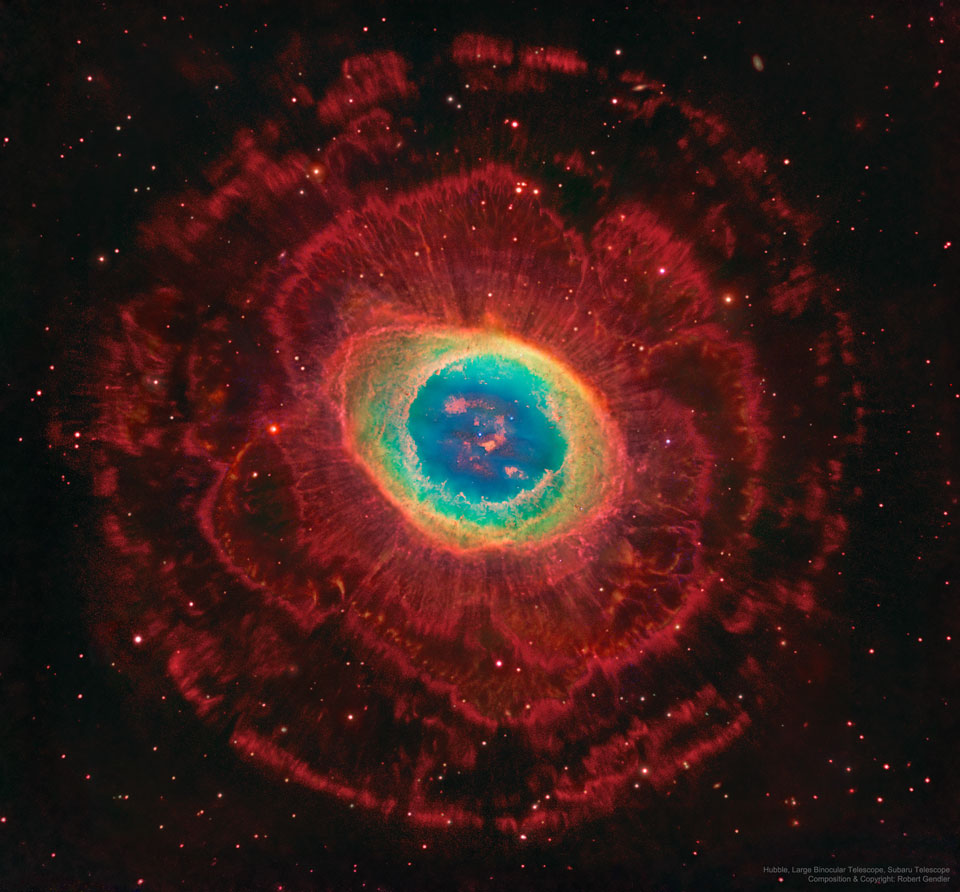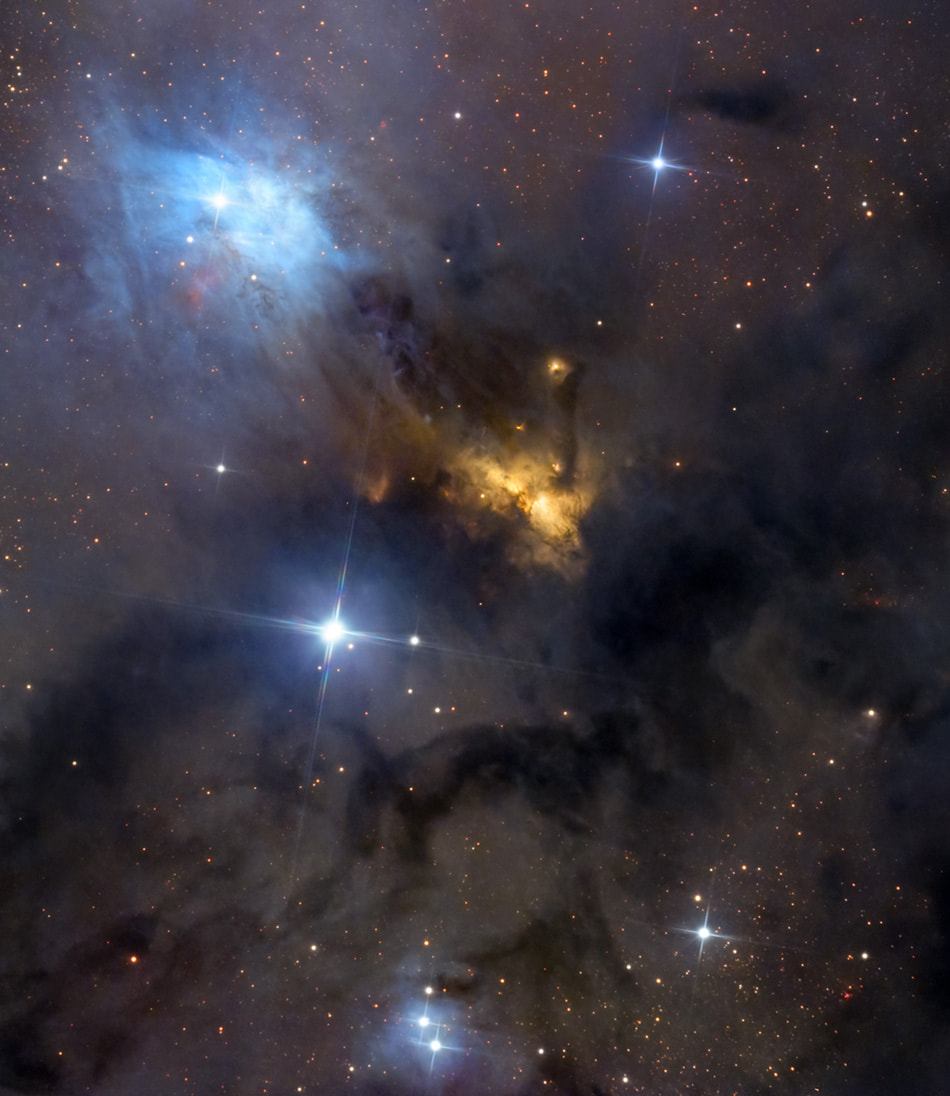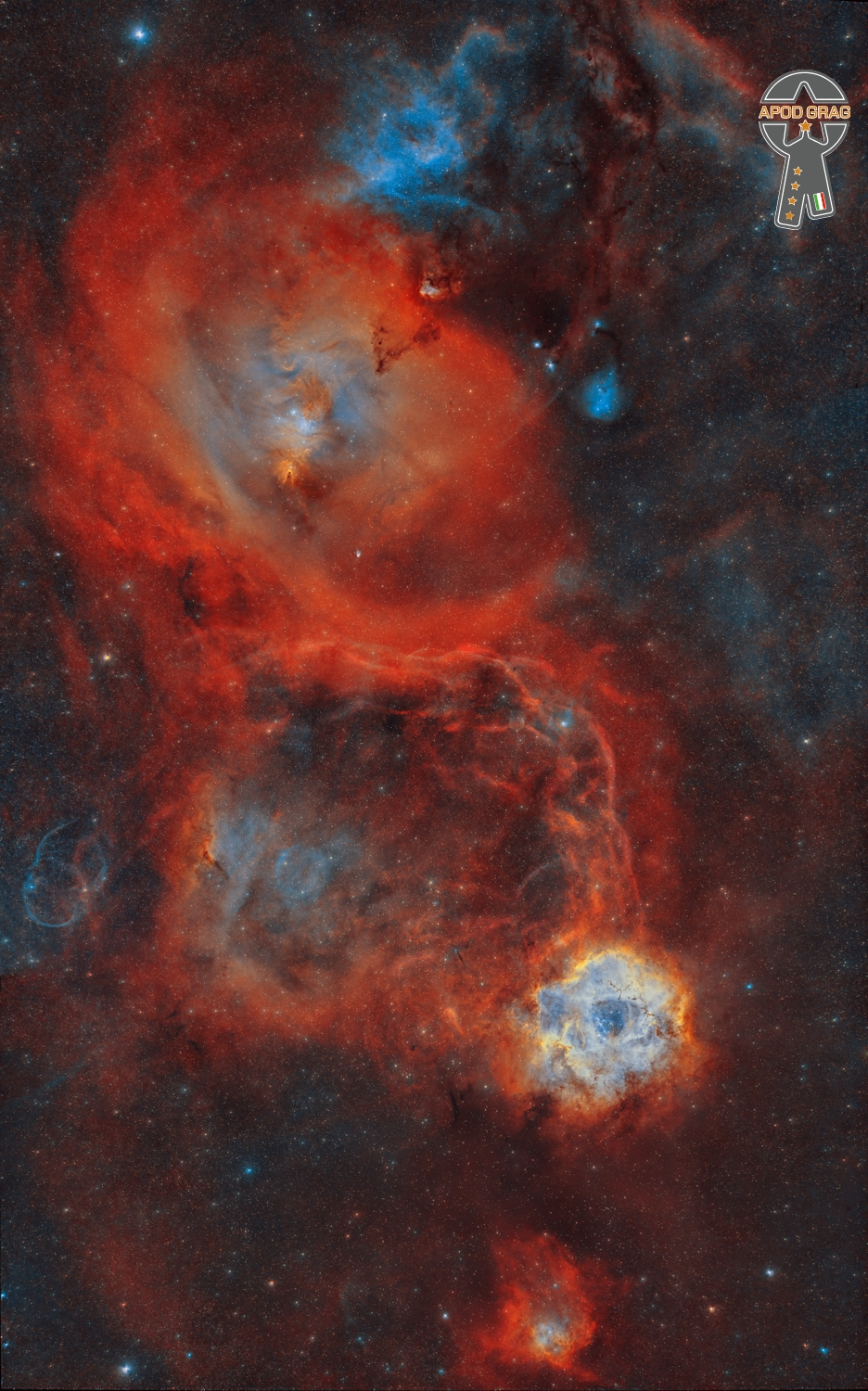Blog
The Ring Nebula (M57) is more complicated than it appears through a small telescope. The easily visible central ring is about one light-year across, but this remarkably deep exposure – a collaborative effort combining data from three different large telescopes –explores the looping filaments of glowing gas extending much farther from the nebula‘s central star. This composite image includes red light emitted by hydrogen as well as visible and infrared light. The Ring Nebula is an elongated planetary nebula, a type of nebula created when a Sun-like star evolves to throw off its outer atmosphere and become a white dwarf star. The Ring Nebula is about 2,500 light-years away toward the musical constellation Lyra.

Steve Khan (born Steven Harris Cahn; April 28, 1947) is an American jazz guitarist.
Steven Harris Cahn was born in Los Angeles. His father, lyricist Sammy Cahn, “loved to hear any and all versions of his songs”. He took piano lessons as a child and played drums for the surf rock band the Chantays. The band’s guitarist exposed him to the albums Tough Talk by The Crusaders and Movin’ Wesby Wes Montgomery. In his late teens he quit the drums and started playing guitar. He was a member of the R&B band Friends of Distinction, recorded with keyboardist Phil Moore, then played on the album Bullittby Wilton Felder (“one of my heroes”). Despite his father’s advice to avoid a career in the music business, he graduated from UCLA with a degree in music composition and theory.
In the early 1970s, he performed in an acoustic guitar duo with Larry Coryell and was a member of the Brecker Brothers band. As a session musician, he appeared on albums by Ashford & Simpson, Rupert Holmes, Billy Joel, and Steely Dan. He was signed to Columbia Records through the efforts of Bobby Colomby and Bob James. On his first three albums Tightrope (1977), The Blue Man (1978), and Arrows(1979), he was trying “to single-handledly keep alive the sound of the original Brecker Brothers band.”His next album was Evidence (1980), which contained an eighteen-minute medley of songs by Thelonious Monk.
more...
Oliver Jackson (April 28, 1933 – May 29, 1994), also known as Bops Junior, was an American jazz drummer.
Jackson was born in Detroit, Michigan, United States, where he played in the 1940s with Thad Jones, Tommy Flanagan, and Wardell Gray, and had a variety show with Eddie Locke called Bop & Locke. After working with Yusef Lateef from 1954 until 1956, he moved to New York, where he played regularly at the Metropole in 1957 and 1958. Following this he worked with Teddy Wilson, Charlie Shavers (1959–61), Buck Clayton, Benny Goodman(1962), Lionel Hampton (1962–64), Kenny Burrell, Earl Hines (1964–70 intermittently) and the JPJ Quartet with Budd Johnson. Later in life he played with Sy Oliver (1975–80), Oscar Peterson, and George Wein‘s Newport All-Stars. As a bandleader, Jackson led a 1961 date in Switzerland, and recorded at least five albums for Black & Blue Records between 1977 and 1984.
His brother, bassist Ali Jackson, performed with him both at the beginning and towards the end of their careers. His nephew, Ali Jackson Jr., is a jazz drummer.
Jackson died from heart failure in New York City at the age of 61.
more...Prudencio Mario Bauzá Cárdenas (April 28, 1911 – July 11, 1993) was an Afro-Cuban jazz, and jazzmusician. He was among the first to introduce Cuban music to the United States by bringing Cuban musical styles to the New York City jazz scene. While Cuban bands had had popular jazz tunes in their repertoire for years, Bauzá’s composition “Tangá” was the first piece to blend jazz harmony and arranging technique, with jazz soloists and Afro-Cuban rhythms. It is considered the first true Afro-Cuban jazz tune.
As a child he studied clarinet becoming recognized as a child prodigy on the instrument and was featured with the Havana Symphony at the age of 11. Bauzá then performed on clarinet and bass clarinet with pianist Antonio María Romeu‘s charanga (flute and violins) orchestra. This proved a fateful event as the orchestra visited New York City to record in 1926. Bauzá’s stayed with his cousin, trumpeter René Endreira, who was a Harlem resident and played with The Santo Domingo Serenaders, a band was made up of Panamanians, Cubans, and Puerto Ricans playing jazz. The teenage Bauzá was impressed with Harlem’s African American community and the freedom they had. He also witnessed a performance of George Gershwin‘s “Rhapsody in Blue” and was inspired with saxophonist Frankie Trumbauer‘s feature in the piece. Upon his return to Cuba, he vowed he would return to New York City to become a jazz musician doing so in 1930 learning to play the alto saxophone while maintaining his clarinet technique. A chance encounter with vocalist Cuban vocalist Antonio Machin, who needed a trumpet player for an upcoming record date he was leading, gave Bauzá an unusual opportunity. Machin was the vocalist for the Don Azpiazú Havana Casino Orchestra who had taken New York City by storm with their public performances and recent hit recording of “El Manisero” (“The Peanut Vendor”). Machin was offered a record date to record four tunes. When Machin performed solo, he did so with two guitars, a trumpet, and himself on maracas. All the trumpet players that knew how to play in the Cuban style who were part of Azpiazú’s orchestra had left to return to Cuba. Faced with a dilemma Bauzá offered his services to Machin because he knew the finger positions on the horn buying a trumpet and in two weeks developed enough technique to play on the recordings. He now devoted his time to playing the instrument being inspired by Louis Armstrong. By 1933, Bauzá had been hired as lead trumpeter and musical director for drummer Chick Webb‘s Orchestra, and it was during this time with Webb that Bauzá both met fellow trumpeter Dizzy Gillespie, and allegedly discovered and brought into the band singer Ella Fitzgerald.
more...
vdB 1231, as designated in the van den Bergh catalog2, is a blue reflection nebula7 located in the constellation Serpens approximately 800 light years (230 +/- 20 parsecs)3 from the Earth. This colorful nebula is embedded in a large cloud of dust and gas known as the Serpens Cloud3. This cloud overlays a rich field of background Milky Way stars. These background stars appear to be heavily “reddened” by the cloud’s intervening dust. A large dark nebula extending throughout the region is cataloged Dobashi 12605,6. These areas of dense dust obscures background stars and other celestial objects. The bright blue central nebula shines from light reflected from the bright star designed HD 1706341. The blue color is a result of the surrounding dust reflecting the shorter wavelengths of light more efficiently than longer wavelengths. This is essentially the same phenomena that makes our Earthly sky appear blue.

James Lee Keltner (born April 27, 1942) is an American drummer and percussionist known primarily for his session work. He was characterized by Bob Dylan biographer Howard Sounes as “the leading session drummer in America”.
Keltner was inspired to start playing because of an interest in jazz, but the popularity of jazz was declining during the late 1950s and early 1960s, and it was the explosion of pop/rock in the mid-1960s that enabled him to break into recording work in Los Angeles. His first gig as a session musician was recording “She’s Just My Style” for the pop group Gary Lewis and the Playboys.
Keltner’s music career was hardly paying a living, and for several years at the outset he was supported by his wife. Toward the end of the 1960s, he finally began getting regular session work and eventually became one of the busiest drummers in Los Angeles. His earliest credited performances on record were with Gabor Szabo on the 1968 album Bacchanal.
In 1968, Keltner was also working in a music shop in Pasadena just down the street from the old Ice House coffeehouse when he was recruited to play drums in a “psychedelic” vocal group named “MC Squared” along with Michael Crowley, Michael Clough, Linda Carey—all from the folk group The Back Porch Majority)—and session guitarist/bassist Randy Cierley Sterling. They were signed by Mo Ostin and recorded an album for Warner/Reprise originally titled “MC Squared” which has later been re-mastered and re-released in 2012 with the album title “Tantalizing Colors.” They appeared live that same year on the Hugh Hefner / Playboy Magazine television show Playboy After Dark playing two songs: an original by MC Squared members Michael Clough and Michael Crowley titled “I Know You” and a version of the Fred Neilsong Everybody’s Talkin’. Both Playboy After Dark performances with Keltner playing drums can currently be viewed on YouTube.
It was his work with Leon Russell playing on Delaney & Bonnie’s Accept No Substitute that attracted the attention of Joe Cocker, who recruited Russell and everyone else he could out of the Delaney & Bonnie band for his Mad Dogs & Englishmen tour. Playing with Joe Cocker led to work in 1970 and 1971, on records by Carly Simon (No Secrets), Barbra Streisand (Barbra Joan Streisand), Booker T. Jones (Booker T. & Priscilla), George Harrison (The Concert for Bangladesh) and John Lennon (Imagine).
more...Conrad Henry Kirnon (April 27, 1927 – November 30, 1994) known professionally as Connie Kay, was an American jazz and R&B drummer, who was a member of the Modern Jazz Quartet.
Self-taught on drums, Kay began performing in Los Angeles in the mid-1940s. His drumming is recorded in The Hunt, the recording of a famous Los Angeles jam session featuring the dueling tenors of Dexter Gordon and Wardell Gray on July 6, 1947. He recorded with Lester Young‘s quintet from 1949 to 1955 and with Stan Getz, Coleman Hawkins, Charlie Parker, and Miles Davis.
Kay did R&B sessions for Atlantic Records in the early to mid-1950s, and he was featured on hit records such as Shake, Rattle and Roll by Big Joe Turner and Ruth Brown‘s (Mama) He Treats Your Daughter Mean.
Kay joined the Modern Jazz Quartet in 1955, replacing original drummer Kenny Clarke. He remained through the group’s dissolution in 1974 and occasional reunions into the 1990s. In addition to his MJQ compatriots, he had an enduring partnership with cool jazz altoist Paul Desmond through the first half of the 1960s. He played drums on several of Irish singer-songwriter Van Morrison‘s albums: Astral Weeks, one song on Saint Dominic’s Preview, and four songs on Tupelo Honey.
more...
Friday April 26th 6pm. Accompanying the Shabbat Service with Inbal Sharett-Singer, Jayson Rodovsky, Jeff Bailey, Pete Whitman and mick laBriola.
more...The Rosette Nebula (also known as Caldwell 49) is an H II region located near one end of a giant molecular cloud in the Monoceros region of the Milky Way Galaxy. The open cluster NGC 2244(Caldwell 50) is closely associated with the nebulosity, the stars of the cluster having been formedfrom the nebula’s matter.
The nebula has been noted to be having a shape reminiscent of a human skull, and is sometimes referred to as the “Skull Nebula.” It is not to be confused with NGC 246, which is also nicknamed the “Skull Nebula. Here is the panoramic photo of the Rosette Nebula, Cone Nebula, Christmas tree.
Following these two clear nights, without a Moon at the start of the night, I took a wide shot of the Rosette nebula, of the cone / Christmas tree, there are 3 photos with the 300mm f2.8 canon to make this panorama.
There are 4 hours per panel with unit exposures of 5 min.

more...
Shankar Lakshminarayana (born 26 April 1950), better known as L. Shankar, is an Indian violinist, singer and composer who also goes by the stage name Shenkar. Known for his innovative contributions to world music, he is often regarded as one of the pioneers of East- West fusion, blending the rich traditions of Indian classical with Western genres such as jazz, rock, and electronic music. His world music albums with the band Shakti during the mid-70s became the ‘standard to gauge the playing and composing abilities of any world musician following in Shakti’s expansive wake”. He is credited with inventing the stereophonic double violin (known as the LSD – L.Shankar Double Violin), which covers the orchestral string family’s range. In 1990, Shankar’s talam-bending (time cycles of 9 3/4 & 6 3/4 beats) Pancha Nadai Pallavi’ album was on the Billboard top ten world music chart for three months becoming the first traditional Indian record to reach those heights. His 1995 Raga Abheri album was nominated for a Grammy Award, in the Best World Music Album category.With Peter Gabriel, he worked on the Grammy winning album Passion(1989), the soundtrack album for Martin Scorsese’s The Last Temptation of Christ(1988), and wrote and performed vocals on Mel Gibson’s ‘The Passion of the Christ’ (2004) which won a Dove Award for Instrumental Album of the Year at the 36th GMA Dove Awards. He also worked on the soundtrack for the 2002 film Queen of the Damned with Jonathan Davis and Richard Gibbs and recorded eight songs of which five were picked for the movie. Additionally, he collaborated on the original score for NBC’s hit TV series Heroes with Wendy & Lisa. As an acclaimed musician, Shankar is ranked as one of the top famous male violinists by Ranker and one amongst the greatest violinists of popular music by Digital Dream Door. His extensive body of work spans a wide spectrum of genres, encompassing vocal and instrumental compositions.
more...Theodore Marcus “Teddy” Edwards (April 26, 1924 – April 20, 2003) was an American jazz tenor saxophonist.
Edwards was born in Jackson, Mississippi, United States. He learned to play at a very early age, first on alto saxophone and then clarinet.
His uncle sent for him to come to Detroit to live because he felt opportunities were better. Due to illness in the family, he went back to Jackson and ventured to Alexandria, Louisiana. He was persuaded by Ernie Fields to join his band after going to Tampa, Florida. Edwards had planned to go to New York City, but Fields convinced him he could get there by way of Washington, D.C., if he worked with his band. Edwards ended up at the “Club Alabam” on Central Avenue in Los Angeles, which later became his city of residence.
more...John Ned Shines (April 26, 1915 – April 20, 1992) was an American blues singer and guitarist.
Shines was born in Frayser, Tennessee, today a neighborhood of Memphis. He was taught to play the guitar by his mother and spent most of his childhood in Memphis, playing slide guitar at an early age in juke joints and on the street. He moved to Hughes, Arkansas, in 1932 and worked on farms for three years, putting aside his music career. A chance meeting with Robert Johnson, his greatest influence, gave him the inspiration to return to music. In 1935, Shines began traveling with Johnson, touring in the United States and Canada.[1] They parted in 1937, one year before Johnson’s death.
Shines played throughout the southern United States until 1941, when he settled in Chicago. There he found work in the construction industry but continued to play in local bars.
He made his first recording in 1946 for Columbia Records, but the takes were never released. He recorded for Chess Records in 1950, but again no records were released. He kept playing with blues musicians in the Chicago area for several more years. In 1952, Shines recorded what is considered his best work, for J.O.B. Records. The recordings were a commercial failure, and Shines, frustrated with the music industry, sold his equipment and returned to working in construction.
more...More Posts
- Rita Marley
- Don Ellis
- Johnny Hodges
- World Music Kommuna Lux
- Daily Roots Augustus Pablo
- Cosmos UGC 12295
- Graham Lear
- Charles McPherson
- Billy Taylor
- World Music The Funkees
- Daily Roots Barrington Levy
- JEWBALAYA August 6th & 13th 2023
- A Chorus Line by Theatre 55 Last Performance
- Cosmos Mandel Wilson 9
- Bill Lee
- Steve Lacy
- “Champion Jack” Dupree
- World Music Tinariwen
- Daily Roots Jacob Miller
- A Chorus Line by Theatre 55
